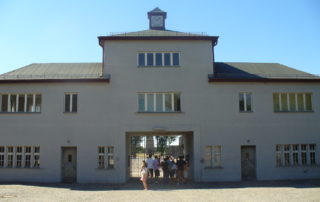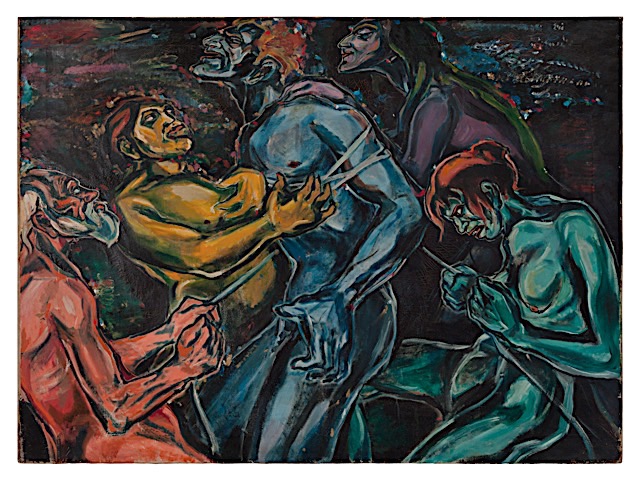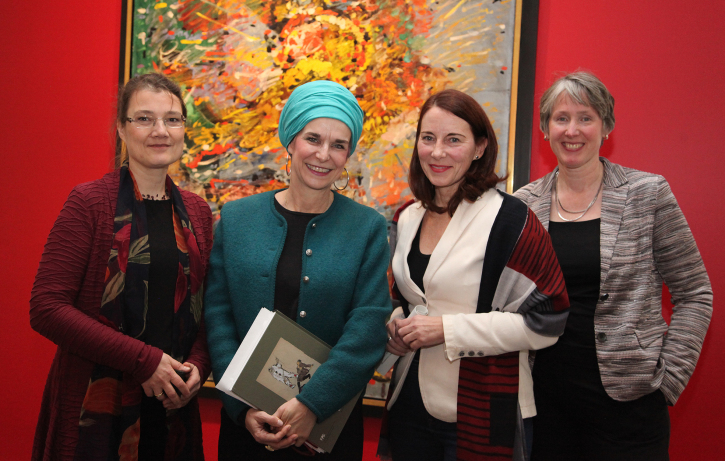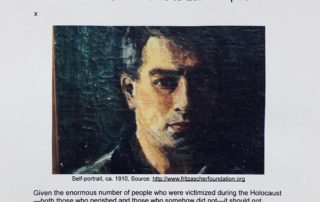Rachel Stern2020-03-03T09:05:47-05:00February 18th, 2019|Exhibitions, Past Exhibitions|
“In the Country of Numbers. Where the Men have no Names” tells the story of the detention and exile of November pogrom prisoners in the Sachsenhausen concentration camp on the basis of twelve individual destinies. One of those individuals is Fritz Ascher. The interviews presented in the exhibition with children and grandchildren of the persecuted as well as family biographical photos and documents are new material first shown in Germany, which was researched in the USA, Great Britain and Israel. More than 6,300 Jewish men were brought to the Sachsenhausen concentration camp after the November pogroms in 1938. After a few weeks, the vast majority was set free, with the condition to emigrate immediately from Germany. Many have therefore [...]
Rachel Stern2018-12-04T11:57:56-05:00December 27th, 2017|Select Press Coverage|
Fritz-Ascher-Retrospektive „Leben ist Glühn“ Die Wiederentdeckung des Expressionisten Fritz Ascher: eine Doppelausstellung in der Villa Oppenheim und im Potsdam Museum. by Elke Linda Buchholz Einen so vollständig vergessenen Künstler zurückzuholen in die Aufmerksamkeit, braucht Kraft, Geduld und kreative Energie. Vor 30 Jahren stieß die deutsch-amerikanische Kuratorin Rachel Stern bei einem Sammler auf Arbeiten von Fritz Ascher. Sie hatte noch nie von ihm gehört. Jetzt ist sie als quasi weltweit einzige Expertin für den 1893 geborenen Maler wieder zurück in der Stadt, wo auch er einst gelebt und gearbeitet hat. Hier bei Max Liebermann holte der junge Wilde sich als 16-Jähriger nach abgebrochener Schule die höheren Weihen einer Empfehlung an die Königsberger Kunstakademie und startete zwischen Secessionisten und Expressionisten seine Karriere. [...]
Rachel Stern2018-12-04T12:05:52-05:00December 26th, 2017|Select Press Coverage|
Der vergessene Expressionist Das Potsdam-Museum zeigt Werke des von den Nazis verfolgten Malers Fritz Ascher by Mathias Richter Sie gehören zur sogenannten verlorenen Generation. Künstler wie Gertrude Sandmann, Magda Langenstrass-Uhlig oder Eric Isenburger. Sie hatten Anfang der 30er Jahre grosse Ambitionen und wahrscheinlich eine grosse Karriere vor sich. Doch mit dem Machtantritt von Adolf Hitler erhielten sie Berufsverbot, wurden verfolgt, ihre Werke als "entartete Kunst" verfemt. Wer die Nazi-Zeit überlebte war vergessen und stand vor dem Nichts. Einer der Angehörigen dieser verlorenen Generation ist Fritz Ascher. Das Potsdam-Museum widmet dem radikalen Berliner Expressionisten in Kooperation mit der Villa Oppenheim in Berlin-Charlottenburg von Sonntag an eine Sonderausstellung. 80 Gemälde und Grafiken sind in den beiden Museen zu sehen, davon etwa 50 [...]
Rachel Stern2018-12-04T12:14:23-05:00December 22nd, 2017|Newsletter|
Dear Friends, I am humbled and honored to have received the Lea and Hans Grundig Prize for my work about Fritz Ascher. Right on time for his 125th birthday, the Fritz Ascher retrospective is now open in Berlin and Potsdam, the two places where the artist lived and worked. Museum Charlottenburg-Wilmersdorf in der Villa Oppenheim in Berlin exhibits an overview of the artist’s creative development, with a focus on works that relate to Berlin. We see his sketch of the artist Max Liebermann as well as his love for music and performance in Weimar Republic paintings like “Beethoven” and “Bajazzo and Artists”. After surviving the Nazi terror regime in hiding in the Berlin Grunewald neighborhood, he painted these works over [...]
Rachel Stern2018-12-04T12:33:00-05:00September 1st, 2017|Newsletter|
Dear Friends, It was fun to attend the opening of “Hauptstadtfussball” at the Ephraim Palais in Berlin, celebrating the 125th anniversary of the Berlin soccer club Herta BSC and its local rivals. I learned so many things about soccer in Berlin, and about Herta BSC in this creative, well researched exhibition. And you can see Fritz Ascher’s “Soccer Players” from c. 1916! It will be on view until January 8, 2018. link Thank you to Sven Goldmann for bringing Fritz Ascher alive in his full page piece in the German newspaper Der Tagesspiegel! link Here in New York, the preparations for “‘Beauteous Strivings.’ Fritz Ascher - Works on Paper” at the New York Studio School are in full swing. The New [...]
Newsletter #3 October 2015
Rachel Stern2016-12-08T00:03:24-05:00October 25th, 2015|Newsletter|
Best wishes to our Jewish friends in 5776! May it be a good and peaceful year for everyone. EXHIBITION A few days ago, the exhibition "»Making Amends« Compensation and Restitutions in a Divided Berlin" was opened at the Gedenkstätte deutscher Widerstand in Berlin. The exhibition, which was organized by a team of the Aktives Museum and the Gedenk- und Bildungsstätte Haus der Wannsee-Konferenz Berlin is celebrating the 70th anniversary of the liberation from the Nazi terror regime with this in-depth examination of the practice of restitution after 1945. Especially in Berlin, where during the Cold War two completely different concepts of restitution existed side-by-side, their political framework and its consequences for the restitution procedures can be demonstrated like nowhere else. [...]
Rachel Stern2021-02-25T04:48:57-05:00January 18th, 2015|Select Press Coverage|
Fritz Ascher: from Golems to Landscapes by Ori Z. Soltes Given the enormous number of people who were victimized during the Holocaust—both those who perished and those who somehow did not—it should not surprise us that, as time goes by, narratives still continue to emerge reflecting the varied experiences of these victims and their tormentors or saviors. Among these there are many artists—artists, like Felix Nussbaum (1904-1944), who were producing high-level work, and others less skilled—who did not survive but left behind bodies of work that provoke the question: what if? Had these artists not been destroyed by the Nazis, what might they have accomplished and what songs of praise might art historians now be singing about them? There [...]
Rachel Stern2018-12-04T12:46:50-05:00December 23rd, 2014|Select Press Coverage|
If not for the Nazis, he may have been the next Leonardo German Expressionist painter Fritz Ascher survived the Holocaust, but his career never recovered. A new foundation is trying to change that by Cathryn J. Prince NEW YORK – “Artist, interrupted” — two words that describe the accomplished German Expressionist painter Fritz Ascher, a Berlin-born artist who was persecuted, ostracized and banned under the Nazi regime. But now, if Rachel Stern has her way, Fritz Ascher will be “artist, re-discovered. “The intensity, the strong energy, the colors, the forms,” Stern said recalling the first time she saw his work in the mid-80s. It was love at first sight. In fact, Ascher’s work so touched Stern she started researching the [...]









